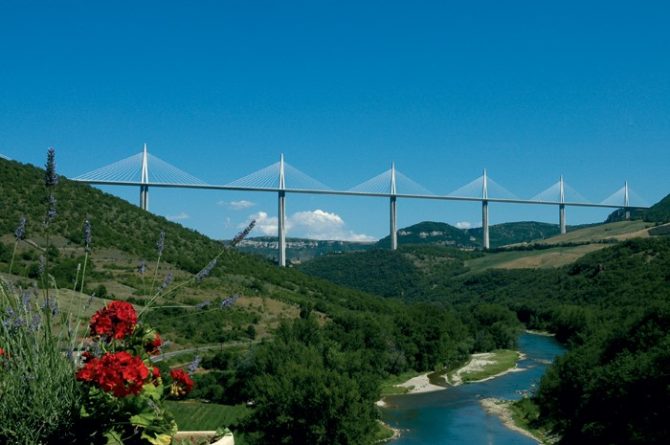The Viaduc de Millau

It’s no secret that the British and French enjoy something of a love-hate relationship. The two countries famously fought a war that dragged on for a hundred years, and there is still no love lost today whenever the two sides clash on a rugby pitch. But the relationship has not always been confrontational. The hundredth anniversary of the 1904 Entente Cordiale that set the seal on a budding friendship between the two countries was celebrated with much good natured fanfare on both sides of La Manche (the English Channel), and it must be said that when the British and French are of a mind to cooperate the results can be impressive.
Think Concorde, the first and only successful supersonic passenger jet of the aeronautic age. Think also Channel Tunnel, one of the 20th century’s masterpieces of civil engineering. And in this new millennium and century think Millau Viaduct, the product of British design and French engineering prowess that sets a soaring example of the bridge builder’s art. Opened in 2004, the spectacular cable-stayed viaduct spanning the valley of the Tarn River near Millau in southwest France, is definitely, as the Michelin Guide says, well worth the trip.
Down the years it has been unkindly suggested that the folks responsible for Michelin guidebooks invented the notions of “vaut le voyage” and “mérite un détour” because those journeys and side trips required more driving by tourists, and thus faster tire wear and higher profits for the parent company. But even if you do spend a bit more time, run up some extra miles and lose extra rubber to the road by visiting Millau’s viaduct, go for it, because the bridge is an architectural triumph and an engineering tour de force realized by British architects Foster + Partners, French structural engineer Michel Virlogeux and the French construction consortium Eiffage which, as its name suggests, traces its pedigree back to the building of the Eiffel Tower and, somewhat later, the construction of Sydney’s iconic Opera House.
Until you actually visit the grand Viaduct de Millau it is impossible to grasp the gigantic scale of the €400 million project. Nothing prepares you for the sheer breathtaking grandeur of the structure as it looms across the arid scrubland of the causses—the limestone plateaus that make up the southern part of the Massif Central before it gives way to the coastal plains of Languedoc to the south. The bridge’s deck, which carries the four lanes of the E11/A75 autoroute across the valley, may not be the highest in the world—that honor goes to the Si Du River bridge completed in China’s Hubei province last year. But it is nearly twice as tall as the previous European record-holders in Austria and Italy, and the mast atop the bridge’s P2 pylon, at 1,125 feet, makes the Millau bridge the highest structure of its kind in the world—easily surpassing the 1,063 feet of the Eiffel Tower and all other bridges in Europe.
The bridge’s seven pylons support an 8-span steel roadway measuring 8,070 feet in length—that’s more than a third longer than the Champs Elysées in Paris—and weighing some 36,000 tons—five times the weight of the Eiffel Tower. Each pylon is topped by a mast from which high tensile steel cables bundled into 154 stays descend to add support from above for the deck, which slopes gently—a 3% incline—from the Causse du Larzac on the northern side of the Tarn Valley up to the Causse Rouge on the southern side, curving slightly to give drivers better visibility. Despite the huge amounts of material involved—3 million cubic feet of concrete, 21,000 tons of steel reinforcement, and a further 5,500 tons of pre-stressed steel for the cables and shrouds—the viaduct gives the impression of floating over the valley with what architect Norman Foster describes as “the delicacy of a butterfly”.
Opponents of the viaduct—and there were many, ranging from the World Wildlife Fund to the French public transport lobby FNAUT—have largely been denied the satisfaction of seeing some of their more dire predictions come true. As with the Eiffel Tower, many predicted the Millau Viaduct would be a financial disaster, with few users. But as of October 2010 some 27 million vehicles had crossed over the bridge. That success has in turn brought warnings that the rugged expanse of the Grands Causses Regional Park, through which the A75 autoroute passes, might in some way be blighted by the increased traffic and larger number of visitors. But so far the most significant effect of the bridge and the highway it carries has been to focus attention on a hitherto hidden and under-appreciated region of southern France.
Happiest of all with the viaduct’s success is the town of Millau which, until the bridge was built, found itself each summer at the center of one of France’s legendarily monumental traffic jams, as vacationers in cars vied with commercial vehicles to squeeze through the local bottleneck caused by the old highway as it wound its way down into the valley and across the river. Now Millau’s citizens can get on with what they do best—making leather gloves for the fashion houses of Europe, among other things—while admiring the beautiful bridge that has lifted the annual traffic siege.
Visitors to the viaduct should certainly cross the bridge; the toll charge for a car is €7.90 in July and August and €6.10 the rest of the year, and can be paid in cash or by credit card. But they should also stop at the specially built viewing area of Brocuéjouls on the north side of the gorge—look for signs to the Aire du Viaduc de Millau—which is accessible from both the southbound and northbound lanes. There’s information on hand about how the viaduct was built, and scale models of rival designs that lost out when the jury of experts chose Foster’s dramatic cement-and-steel “butterfly”. There’s also a splendid view of the viaduct itself, of course, which in certain weather conditions seems to be floating freely above the clouds that fill the valley beneath it.
NOTEBOOK
Before the viaduct opened, Millau already had a landmark bridge, or at least the two arches that remained of its 12th-century stone span across the Tarn, topped by a 15th-century mill. As far back as the 1st century AD, the Gallo-Roman settlement of Condatomagus, at the confluent of the Tarn and Dourbie rivers, was a prominent pottery center, producing red terracotta crockery that was exported throughout the Roman Empire. During the Middle Ages, sheep raised in the surrounding causses led to tanneries and a booming glove industry that lasted into the 20th century. Today the city remains a glove center, making luxury gloves and other leather goods for the fashion world.
Musée de Millau Archaeology, pottery and glove-making. Hôtel de Pégayrolles, Place Foch, Millau, 05.65.59.01.08. website
Les Bâteliers du Viaduc offer small-boat tours on the Tarn that pass beneath the bridge. Place du 19 Mars, Creissels, 05.65.60.17.91. website
Château de Creissels A delightful and reasonably priced small hotel and restaurant in a 12th-century château (and a modern extension), with views of the valley and the viaduct. Place du Prieur, Creissels, 05.65.60.16.59.
ENVIRONS
As well as the spectacular canyon of the Gorges du Tarn, the town of Roquefort-sur- Soulzon, famous for its blue-veined sheep cheese, is within easy reach (even in summer you’ll need a warm jacket for visiting the caves where the cheese is aged) and so are the fortified villages that once belonged to the Knights Templar and the Knights Hospitaliers, or Knights of Malta—La Cavalerie, Sainte-Eulalie-de-Cernon, Saint-Jean-d’Alcas, Vialadu-Pas-de-Jaux and especially La Couvertoirade, with its 15th-century stone walls intact.
Originally published in the November 2010 issue of France Today; updated in September 2011
Share to: Facebook Twitter LinkedIn Email
Leave a reply
Your email address will not be published. Required fields are marked *



